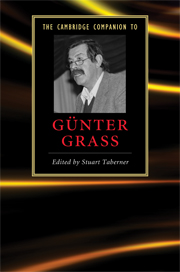Book contents
- Frontmatter
- Introduction
- 1 Biography as politics
- 2 Günter Grass’s political rhetoric
- 3 The exploratory fictions of Günter Grass
- 4 Günter Grass and magical realism
- 5 Günter Grass’s ‘Danzig Quintet’
- 6 Günter Grass and gender
- 7 Authorial construction in From the Diary of a Snail and The Meeting at Telgte
- 8 Günter Grass’s apocalyptic visions
- 9 Günter Grass and German unification
- 10 Günter Grass’s Peeling the Onion
- 11 Günter Grass as poet
- 12 Günter Grass and art
- 13 Günter Grass as dramatist
- 14 Film adaptations of Günter Grass’s prose work
- 15 Günter Grass and his contemporaries in East and West
- Guide to further reading
- Index
4 - Günter Grass and magical realism
Published online by Cambridge University Press: 28 January 2010
- Frontmatter
- Introduction
- 1 Biography as politics
- 2 Günter Grass’s political rhetoric
- 3 The exploratory fictions of Günter Grass
- 4 Günter Grass and magical realism
- 5 Günter Grass’s ‘Danzig Quintet’
- 6 Günter Grass and gender
- 7 Authorial construction in From the Diary of a Snail and The Meeting at Telgte
- 8 Günter Grass’s apocalyptic visions
- 9 Günter Grass and German unification
- 10 Günter Grass’s Peeling the Onion
- 11 Günter Grass as poet
- 12 Günter Grass and art
- 13 Günter Grass as dramatist
- 14 Film adaptations of Günter Grass’s prose work
- 15 Günter Grass and his contemporaries in East and West
- Guide to further reading
- Index
Summary
Magical realism is a genre in which magical elements appear seamlessly within a realistic setting. The term was first coined by the German art critic Franz Roh in 1925 to describe paintings that demonstrated an altered reality. Then in the 1960s magical realism was used by the Venezuelan essayist Arturo Uslar-Pietri specifically in the context of Latin American writers, most notably Jorge Luis Borges, Isabel Allende, and Gabriel García Márquez. The term can be extended to authors outside of the Latin American tradition, however, to Mikhail Bulgakov, who wrote under Stalin, the French novelist Michel Tournier, or the contemporary British-Indian author Salman Rushdie. Their novels of magical realism perceive history as so grotesque that they resist operating within realistic paradigms of representation and resort to other genres steeped in myth, legends and fairy tales. While these genres help Bulgakov to comment on the terrors of Stalinism in The Master and Margarita (written in the 1920s and not published until 1967), in Tournier's The Ogre (1970) the Erlking myth and the fairy-tale world of man-eating ogres conjoin as a means to represent the surreality of life under National Socialism, and in Salman Rushdie's prose Hindu myth and The Arabian Nights: Tales of One Thousand and One Nights (between AD 800 and 900) are important subtexts in the context of colonialism and postcolonialism. Myth and the fairy-tale world also deeply pervade the structures of Günter Grass's work, primarily his novels The Tin Drum (1959), The Flounder (1977) and The Rat (1986).
- Type
- Chapter
- Information
- The Cambridge Companion to Günter Grass , pp. 52 - 66Publisher: Cambridge University PressPrint publication year: 2009

